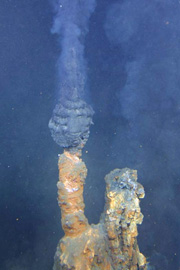Sensitive seamount ecosystems now under threat from mining
7 September 2005
Many seamounts within New Zealand's Exclusive Economic Zone have been stripped of
living organisms above and below the seabed by bottom trawling, in particular from orange
roughy and hoki fishing on the Chatham Rise.
Now, equally damaging, if not more destructive seabed mining is targeting seamounts on the
Kermadec Ridge.
Surface mining of the deep seabed will be blind, and damage caused by it will be indiscriminate,
catastrophic and long-term.
TerraNature Trustee Craig Cary, who is Professor of Environmental Biotechnology at the
University of Waikato, and a specialist in extreme hydrothermal vent ecosystems, says "this type
of mining will alter geochemistry and potentially cause the extinction of unique microbial
flora".
"There is a need to protect flora and fauna of the seabed because so much of it is unknown"
he said.
If mining of the deep seabed proceeds, the real environmental impact of it will never be known,
because a value cannot be placed on species that have not yet been discovered or described,
and ecosystems that are undefined, that will inevitably be damaged or possibly destroyed.
New Zealand is proceeding blindly into the first deepsea mining in the world, with unproven
extraction methods, and consequently an unknown return from operations.
The sensitivity of seamount ecosystems was recognised, though inadequately, when 19 seamounts
including the Rumble III and Brothers seamounts on the Kermadec Ridge, were closed to fishing
in 2000 by the Minister of Fisheries, to safeguard the marine life and habitats they support.
It is widely accepted that bottom trawling is destructive of seamount ecosystems.
Yet equally destructive mineral extraction is now being pursued on Rumble III and
Brothers, and many more Kermadec seamounts.
The previously closed seamounts were selected according to a draft seamount management
strategy developed by the Ministry of Fisheries, with the assistance of the National Institute
of Water and Atmospheric Research. The action of one Ministry has very quickly been
compromised by another.
Neptune Resources describes the deposits of "seafloor massive sulphide" as a new asset mining
class which has not been commercially developed anywhere else in the world. This raises the
question of how the minerals will be effectively and equitably extracted, and calls for
rigorous assessment of the capability of the licensee in undertaking the first operation of
its kind. Deep seabed mining has been considered for overseas locations, but has been
determined to be economically unfeasible.
New Zealand has jurisdiction
over the extensive concentration of seamounts and hydrothermal vent fields in the
Kermadec-Havre and Backarc System in the Lau Basin, which together with the archipelago group,
has been described as the highest productive area of the Southwest Pacific and a centre of
global ecosystem reproduction.
|



